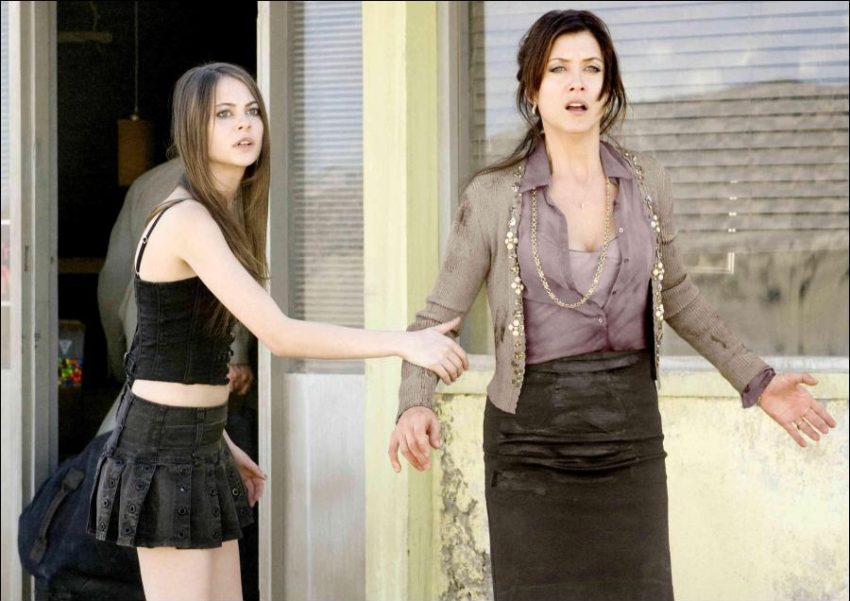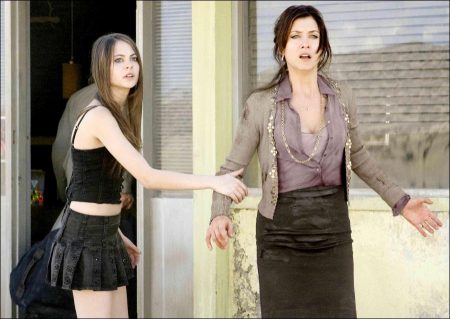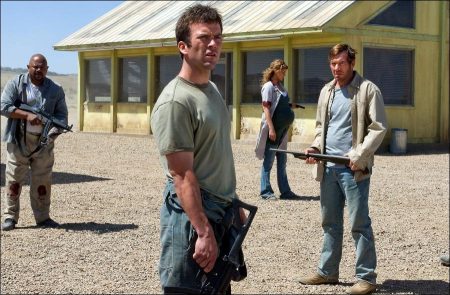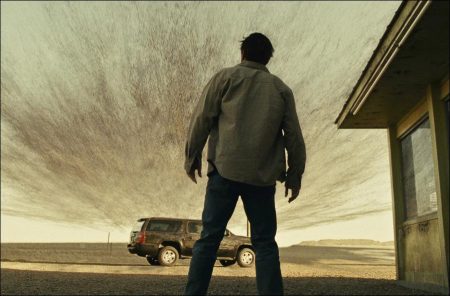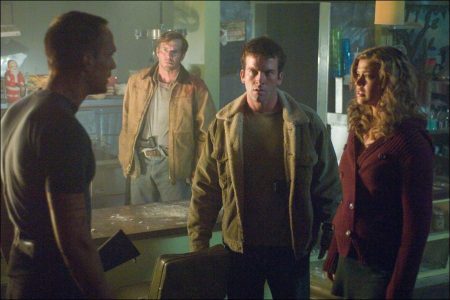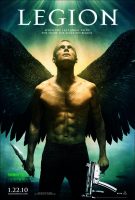Taglines: When the last angel falls, the fight for mankind begins.
In the supernatural action thriller “Legion,” an out-of-the-way diner becomes the unlikely battleground for the survival of the human race. When God loses faith in Mankind, he sends his legion of angels to bring on the Apocalypse. Humanity’s only hope lies in a group of strangers trapped in a desert diner and the Archangel Michael (Paul Bettany).
A dusty diner in the Mojave Desert becomes ground zero for earth’s final showdown in Legion, a startlingly original and terrifying vision of the Apocalypse from director and writer Scott Stewart (Priest). As mankind destroys itself in a savage fury, a small group of people trapped on the edge of nowhere prepare to make a last stand—with the help of a mysterious and powerful stranger.
Unaware of the chaos unfolding around the globe, Bob Hanson (Dennis Quaid), the owner of a remote roadside café, and his partner Percy (Charles S. Dutton) go about business as usual. The restaurant’s beautiful and very pregnant waitress, Charlie (Adrianne Palicki), serves breakfast to Sandra and Howard, a well-heeled suburban couple (Kate Walsh and Jon Tenney) and their teenage daughter Audrey (Willa Holland), as they wait for their car to be repaired by Bob’s son, Jeep (Lucas Black).
When the television goes on the fritz and the phones go out, the group realizes they have lost all communication with the outside world. As they attempt to make sense of what’s happening—An earthquake? A terrorist attack?— an elderly woman (Jeannette Miller) arrives and sweetly orders a steak from Charlie. When her meal arrives, she begins spewing shocking obscenities. In a heartbeat, the fragile old lady develops superhuman strength, launching a grisly attack that leaves Howard critically injured.
A desperate attempt to get medical help ends when an impenetrable cloud of flying insects turns the diner into the only safe haven for miles. As the horrifying truth of their situation sinks in, a stranger (Paul Bettany) joins them with an arsenal of stolen weapons. He informs Charlie that her unborn baby is now humanity’s only hope, and he’s willing to do whatever it takes to save it.
About the Production
Veteran producer David Lancaster first read the script of Legion, a horror movie with an apocalyptic scenario, six years ago. Lancaster, co-president of Bold Films, recalls, “I knew it had strong genre appeal, but I also knew that with the right combination of script, director and cast, it had the potential to appeal to a much larger audience.”
Convinced the film could be far more than a conventional fright-fest, Lancaster enlisted the help of screenwriter and visual effects wizard Scott Stewart to rewrite the script. Intrigued by the idea, Stewart re-conceived the story as a more richly-realized, character-focused piece.
Stewart’s script also took a “less is more” approach to the horror elements. “The original was a more explicit, ‘we’re going to show you everything,’ way of telling the story, as opposed to, ‘we’re going to keep you in the dark for a while,’” he says. “Darkness is the scariest thing. The anticipation of the scare is better than the scare itself. You want to tighten the screws all the time as a filmmaker and ratchet up the tension.
“My favorite scary movies are the ones that take their time to let things evolve, so you get invested in the characters and what they’re going through,” he continues. “Then you can really deliver the goods.”
While working on the story, Stewart kept what he calls “the concept of the uncanny” in mind at all times. “It comes from Freud originally,” he says. “He was defining the difference between the fantastic and the scary. A dragon is fantastic. Dad standing in the middle of the kitchen with an axe is scary. Something familiar put in a context that makes no sense to us emotionally or logically is deeply unsettling. That’s the core conceit of Legion.”
Lancaster was so impressed by Stewart’s ambitious concept for the movie, he asked him to direct it. “Scott grasped the mythology of the story extremely well,” says the producer, whose resume includes A Love Song for Bobbie Long and a co-producer credit on Bobby. “And he executed the rewrite in an extraordinary way. I could see that he and I shared the same vision for the piece. I didn’t care that he was a first-time feature director. I believed in every aspect of what he brought to the script as a writer, and the fact that he had accomplished so much in his visual effects work made it a really exciting gamble to take.”
After studying screenwriting at N.Y.U. Film School, Stewart joined Industrial Light and Magic, the legendary visual effects company established by George Lucas. “It was an incredible education, almost a film school in itself,” he says. “But as a filmmaker, there were things I wanted to be able to do on my own.”
Stewart and two friends then went on to found The Orphanage, which has become one of Hollywood’s pre-eminent visual effects houses, contributing to dozens of blockbusters including Ironman, Pirates of the Caribbean: At World’s End, Night at the Museum and Harry Potter and the Goblet of Fire. Their concept was to be able to make original films in addition to providing special effects for other movies. Legion is, in many respects, the achievement of that dream.
“Having that background helped me pre-visualize Legion,” says Stewart. “I storyboarded virtually every shot of the movie. Having done visual effects for big movies, I was not intimidated by the technical challenges. At the same time, coming from that world, I’m deeply suspicious of the overuse of digital effects, so I wanted to do as much practically as possible.”
The completed script attracted the attention of Clint Culpepper, president of Sony Pictures Entertainment’s Screen Gems label. “Clint is a real showman,” says Stewart. “He knows what he’s on the hunt for, and he zeroed right in on this.”
According to Lancaster, Culpepper was an early believer in the idea that Legion was far more than a genre film. “Clint responded very strongly to this script. He was a singular contributor to this process and I’m eternally grateful to him. With his support, we were able to reach some really fine actors who might not have been interested otherwise.”
The filmmakers saw the apocalyptic setting of Legion as an opportunity to explore larger themes within a highly entertaining action-horror film. While the film is not religious in nature, it does use elements of familiar narratives to tell its tale. “Whether you grew up in a religious home or not, we live in a society that has religion at its core,” Stewart points out. “The movie isn’t attempting to say anything about particular beliefs. It is about the idea of faith, using things that are familiar to us from Judeo-Christian ideology as a way to tell the story. No matter what your bent is philosophically, you can bring that to this movie.”
If it seems provocative, that’s what Stewart intends. “The film pushes buttons and it’s meant to push buttons,” he says. “I hope it’s somewhat controversial. In the end, it’s meant to be entertaining, but I hope it’s thought provoking as well. That’s what takes it out of the realm of the standard thriller.”
The film’s characters represent a cross-section of America: A man on his way to a custody hearing for his child, a married couple struggling with their teenage daughter, a young woman about to have a baby she never wanted. “The characters are surrounded by a comforting normalcy,” says Stewart. “Then, layer by layer, those comforts are stripped away. The sense that everything is okay starts to dissipate. The TV goes out, then the radio. Something is happening, slowly but surely. A little old lady, a minivan family, the ice cream man—all these very familiar things take on new significance. The world’s gotten a little sideways.”
With his long-planned film ready to go into theaters, Lancaster wants to assure audiences that Legion delivers thrills up there with the best of its genre. “I love to make movies,” says the producer. “This one brings together more of the elements of drama and spectacle and production value than I’ve ever experienced. We’ve got great actors, plus visual effects and fight sequences and big action sequences with lots of moving parts and hundreds of extras. With all of the different elements that had to be combined, it was a particularly wonderful project for me.”
Imagining The Apocalypse
The big skies and endless desert panoramas of the American West provide the vistas against which Legion’s epic story plays out. “I’d been reading a lot of Sam Shepard plays and short stories,” Stewart says. “I had an image of a mythic West that may exist only in our minds. This is an homage to that Western landscape.” Stewart assembled a book of photographs that represented his visual plan for the film. “I went out to the desert and photographed abandoned gas stations and road signs with bullet holes in them, things that symbolized lost Americana and the decaying West to me.”
When he began to meet with actors, their agents and managers, he took the book along to showcase his vision for the film. “It was important to me to convey the overall look of the movie,” says the director. “I wanted to show people what I saw in my head.
“It looked like a graphic novel,” he says. “It combined elements of a supernatural action thriller with classic big-sky Westerns. I was just doing what made sense to me. It was a campaign to convince the world that I was going to treat the genre with a lot of respect.”
The film’s production designer, Jeff Higinbotham, took on the task of realizing those photographs as the backdrop for the movie. “We tried to create a gritty desert vernacular that mixes mid-century painter Edward Hopper with the contemporary photographs of Gregory Crewdson,” says Higinbotham. “Scott knew what he wanted, which was a pleasure. Sometimes a director doesn’t know what he wants until you show him something and he’s pretty sure he doesn’t want that thing.” “Our goal was to make it visually seamless,” he continues. “We wanted to find a desolate, isolated area for the diner, a place that time had forgotten. When people watch this picture, I want them to say, where is that diner?”
Stewart decided early on to shoot Legion in a setting that would emphasize the film’s sense of isolation and dread. “Just on a story level, an ‘off the grid’ location made it logical that they would survive the initial onslaught,” he explains. “As the film progresses they are so cut off from the world they have no idea what, if anything, is left of it.”
The filmmakers searched far and wide for a location that looked like an iconic truck stop in the Mojave Desert. “Everybody knows what that’s like, right?” says Stewart. “Try to find one. We had to build it in New Mexico. It looked like it had been there for 50 years. People would actually stop and try to buy gas.” Higinbotham built the set on a windswept swath of land outside Galisteo, with interiors on a small soundstage flexible enough to accommodate the various special effects and stunts that were required.
The construction crew completed work in less than one month despite snow, 50-mile-an-hour winds and rain. “This was one of the first locations I saw,” he says. “And I knew that this was the spot. It had great vistas in all directions and a physical concavity that suited the situation. If you filled this area with water, it would pool at the diner and that’s kind of what happened to our characters.”
Stewart was fortunate to find a director of photography, John Lindley, who shared many of the same visual references and inspirations. “He helped craft a very elevated look for the film,” says the director. “Early on we decided our motto would be ‘No boring shots.’ That meant we were always pushing ourselves to create images that were as graphic as possible to tell our story. In many ways, the film looks like a comic book come to life.”
They also agreed that the look of “Legion” would evolve as the story progresses, says the director. “At first it has a very lost-American feel, like a Hopper painting. But as things progress, the color begins to drain and the look becomes more apocalyptic.”
To amp up the tension in the film, Stewart and Lindley developed visual strategies that keep the audience slight off kilter. “John is skilled at so many things, but in particular, he’s really great at getting in and focusing on the detail,” says Stewart. “He gets right in the middle of the action. I chose to focus on details first and then widen out. It’s the opposite of the classic approach in the American filmmaking industry, where you start with an establishing shot and then you go in. “We always had the camera either really low or really high, almost never at eye-level,” says the director. “It shifts the perspective and becomes a much more dynamic image. We also used overhead shots to create a sense of scale and give us what we called God’s point of view on the events.”
“It’s the best looking film I’ve ever made,” says Lancaster. “I give a lot of the credit to John Lindley. He recognized a chance to do something that a little bit different with this film. It had lots of challenges to it that he embraced. And he’s done a brilliant job.”
Even the costumes were conceived to reinforce the film’s visual scheme. “I am a big believer in using color to help the story,” says Stewart. “We came up with the idea that all of the ‘normal’ people in the story would be wearing muted ‘non-colors’—gray, olive-drab, beige—while the possessed would be clad in bright colors that pop off the screen.”
Wendy Partridge, Legion’s costume designer, created an array of subtle gradations on neutral colors for the main characters. “It was a very intricate and delicate process that turned out to be very fulfilling,” she says. “The hardest thing to do in costuming is to create a single outfit each character has to wear throughout the entire movie. You have only one chance to create that image and, once you’ve created it, you have to live with it for the whole film.”
In addition, as the story progresses, each actor’s outfit had to begin to show the wear and tear of the extreme situation. “The physical deterioration had to mirror the mental and physical stress of the characters,” she notes.
Music was also crucial in establishing the mood of the film and underscoring the dramatic action. “I’m not a fan of movies that look like music videos,” he says. “I prefer music to either run as counterpoint to the visuals or to help tell the underlying emotional story. The jukebox in the diner is almost another character in the film. It plays older music that adds to the feeling that this place is lost in time.”
He was aided in his effort to create a strong musical identity for the story by music supervisor Chris Douridas, who also worked on American Beauty and the Austin Powers movies. “Early on I decided we would only hear songs from practical sources, such as the jukebox or from car stereos,” Stewart says. “The jukebox is almost a Greek chorus for the film. The songs Chris came up with serve as a very compelling counterpoint to what’s happening on screen.”
Legion (2010)
Directed by: Scott Stewart
Starring: Paul Bettany, Dennis Quaid, Tyrese Gibson, Doug Jones, Jon Tenney, Charles S. Dutton, Lucas Black, Kate Walsh, Adrianne Palicki, Kevin Durand, Willa Holland, Jeanette Miller
Screenplay by: Peter Schink
Production Design by: Jeff Higinbotham
Cinematography by: John Lindley
Film Editing by: Steven Kemper
Costume Design by: Wendy Partridge
Set Decoration by: Gabrielle Petrissans
Art Direction by: Austin Gorg
Music by: John Frizzell
MPAA Rating: R for Strong bloody violence, and language.
Studio: Sony ScreenGems
Release Date: January 22, 2010
